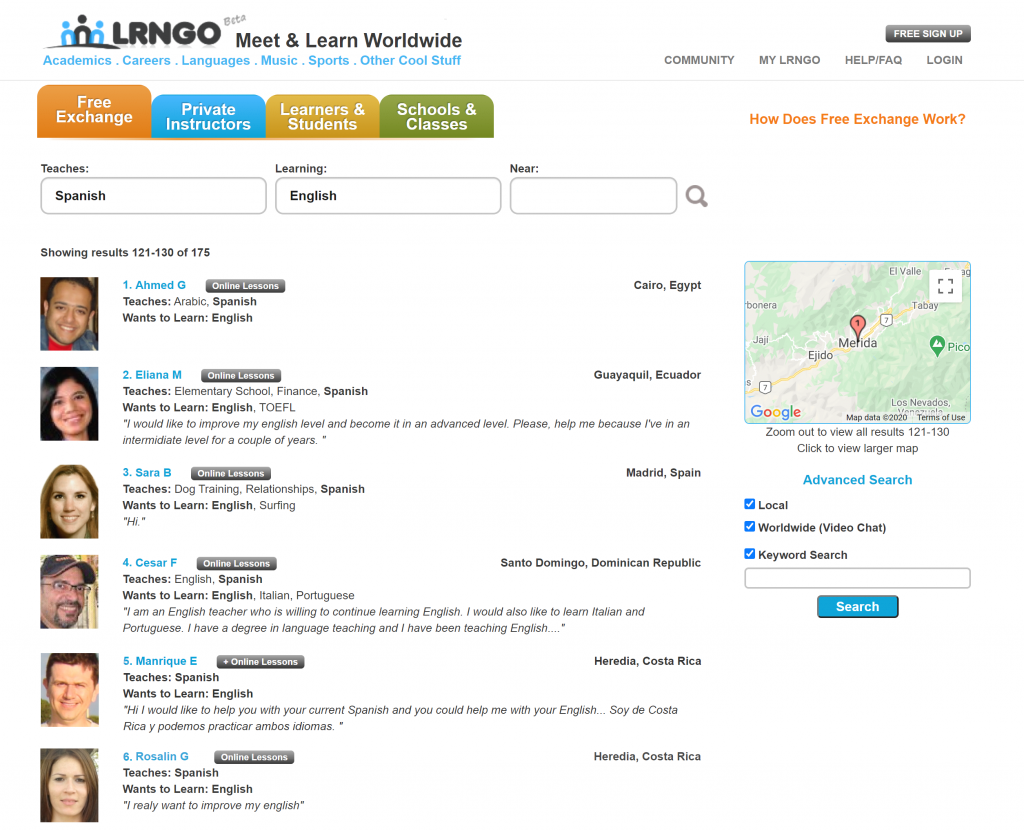Motivating Students To Tell Their Stories in English

Writing in a second language is a daunting task for English as a Second Language students. The author understands, because he once feared composing research papers in a second language. I was able to overcome my fear by using the autobiographical approach to write a master’s project and composing a personal narrative while learning to write in German. This approach combined with constructive feedback gave me confidence. Further, by assisting in the classroom and researching how other teachers used the autobiographical method, I was inspired to develop writing strategies for second language students. The Life Sketch motivates and helps students face their fear of writing in a second language, which prepares them to use the second strategy. The Writing Sketch then aids students in gaining writing skill awareness and realizing needed improvements, as well as planning learning strategies to implement with teacher support.
Transforming ESL Writing Fear
Writing is a daunting task for a number of foreign students who study in America. How can instructors help university-level English as Second Language (hereafter ESL) students reduce writing fear? At one time I feared composing research papers. To minimize my fear, I used the autobiographical method to compose a personal account of my own experience learning to write in German. Simultaneously, I helped teach a university-level ESL class and researched how other teachers used the autobiographical approach with second language students. These experiences gave me the confidence to write a master’s project as well as this article. Below, I address why university-level ESL students study in America and many fear writing.
To overcome fear of writing, I recommend teachers and students consider trying the Life Sketch and Writing Sketch strategies I created from using and researching the autobiographical approach. As a result, I developed confidence, gained skill awareness, and realized needed improvements. By preparing an improvement plan and implementing it with teacher support, I not only wrote papers in my second language, but then found myself wanting to compose more challenging pieces.
Why Do University-Level ESL Students Study in America?
In 2001 Seth Stern reported that many American universities actively recruited ESL students because they paid cash for out of state tuition and living expenses (Monitor 14). These estimated net contributions bolstered the local and national economy over $13 billion annually by 2006 (Nafsa 2). According to the Association of International Educators, by 2019 more than one million international students at U.S. colleges and universities contributed nearly $41 billion to the U.S. economy, and supported 458,290 jobs during the 2018-2019 academic year.
A popular perception has always been to believe that foreign students have studied in the United States because the USA was known as a leader in many fields (Severson and Wood 6). In working with university-level ESL students, I have heard many students state that an American academic degree helps them to get a good job in their country of origin. Since the turn of the century, by studying in the US, international students have taken the opportunity to develop professional and personal contacts, gain cultural awareness, and improve their language skills.
Although it is widely accepted that English is the international language of business, many international students fear academic writing (Blanton 112).
The Challenge of Writing in a Second Language
In order to graduate from an American university and find employment, one must acquire good communication skills. Yet, a number of university-level ESL students fear writing in English due to problem attitudes, lack of skill development, lack of practice using syntax, academic expectations, and lack of audience and cultural awareness (Ferris and Hedgcock 16, Fig. 1.1). Having studied at a German university, as well as through observing and evaluating university-level ESL students when they prepare and present speeches, I can validate the writing challenges articulated.
Attitudes about writing vary among university-level ESL students. Some fear writing because they do not know how to write or do not like to write. Others procrastinate because they know it takes three times longer to prepare assignments in a second language (Leki 2). Kaplan Bass notes students are more anxious about their work being evaluated than the actual act of writing it (Kasper & Petrello 1). Some students fear they will not write perfect papers and dread having to deal with teacher feedback (Blanton 112).
Of course, skill development also affects foreign students’ ability to complete writing assignments. If they have not had adequate experience composing in their first language, to do so in a second language takes even more practice and patience. Moreover, this lack of skills hinders their writing progress (Ferris and Hedgcock 23, Fig. 1.3).

Practice Using Syntax
Although some university-level ESL students can cite English grammar rules, many compositions show they have little experience using American syntax (Leki 23). Further, other students experience difficulties writing due to structural and rhetorical differences between their language and English (Dong 281-282), particularly with more difficult language pairs.
Academic Expectations
When university-level ESL students begin their studies in America, often a significant number of them are not aware of academic expectations. Most universities expect students to write exams, compose essays, compile reports, prepare research papers, and give oral presentations. Many students need practice speaking, reading, and writing English; specifically using the print code, grammar and rhetorical devices (Leki 37-38). Markham also states that students need to be “…fluent enough in English to write without constant need for translation (e-mail 05/18/04).” This level of skill enables students to choose a topic more easily, develop and outline ideas, do research, and write a first draft. After editing their piece and receiving feedback, they can integrate comments and polish their piece for grading (Kasper and Petrello 3).
Audience and Cultural Awareness
Lastly, international students need to develop cultural awareness to reach an American audience. By learning to think and write linearly as well as use cultural idioms and illustrations, university-level ESL students grab the attention of professors and peers. According to Kaplan, foreign students initially think and write according to their world view (Ferris and Hedgcock 17-19). By listening, thinking, speaking, reading, and writing English, university-level ESL students acquire audience and cultural awareness. Yet, how do we help these students face their writing challenges? The solution that is perhaps the most motivational is autobiography.
Using the Autobiographical Method with ESL Students
A number of English, ESL, and Modem Foreign Language teachers have used the autobiographical approach to help students minimize writing anxiety. This method helps students set aside fear and write freely about their lives. In the process, they make sense of their past and gain helpful insights that influence their present and future (Connelly and Clandinin 33-34). If university-level ESL students have developed writing skills in their language, they write more easily in English when using the autobiographical method. It enables them to draw information from their knowledge base or schema according to Dye (3-4) and Markham and Latham (157-158). Since, intermediate to advanced university-level ESL students are their own subject, they need only focus and outline their ideas and write a first draft without concern for spelling, grammar, and style. Later, they edit their piece for feedback, and afterwards polish for grading.
By using the autobiographical method, international students gain experience writing in English, and experience that helps them realize their composing strengths and challenges. Furthermore, they grow their English writing by developing and implementing an improvement plan with teacher support. However, Leki states that university-level ESL students from some cultures are uncomfortable using the narrative method, because it seems unreal to write about themselves in English (67-68). As an alternative, Leki encouraged those students to choose a topic they knew well and focus on content and meaning instead of producing perfectly prepared pieces (75). Because students chose their topic, their attitude about writing changed and their compositions improved in grammar and discourse.
Redirecting Fear & Refocusing on Autobiographical Content
While completing an ESL master’s degree, I discovered Connelly and Clandinin’s autobiographical model for accessing experience (37-40). They required preservice teachers to write a reflective autobiography in order to discover the values supporting their teaching philosophy (39, 70, and 75). Realizing I could lessen my writing fear by using the narrative approach, I discussed the matter with instructors who supported its use. In writing two successful papers without fear, I discovered the values that supported my teaching philosophy and passion for learning languages as portrayed by Kaplan in her book, “French Lessons: A Memoir” (McMillan A8-9). Thus, I decided to write a more challenging paper using the autobiographical approach.
Writing the master’s project was important because I grew up with classmates who spoke, read, and wrote Modem Greek and English fluently. To prove I could do the same, I learned other languages. Another concern was overcoming a fear of writing term papers, which I had had since elementary school. When I wrote a Doctor of Ministry Thesis, it was turned down for lacking focus. To prove that I could write academic papers, I studied Creative Writing and German at one university and ESL at another, and then discovered that writing was my first passion. Instead of taking final exams, academic advisors at both schools allowed me to write a master’s project and use the autobiographical method to develop ESL curriculum. In the paper, I discussed why university level ESL students fear writing. As a solution, I promoted the autobiographical approach by writing my account of learning to write in German. Simultaneously, I assisted in a university-level ESL class and researched how other high school and university teachers used the autobiographical approach to help L2 students minimize writing fear and develop “fluency, clarity, and correctness…(Green 2).” Below, I group the ways teachers have used this method.

Autobiography As Reflection
The following ten teachers had students reflect on the ways they acquired writing skills in order to understand the process and grow their English writing:
Blanton had university-level ESL students compose a brief pre-course and post-course autobiography to determine skill growth (116). She learned that students moved from “decentered writing” to composing for an audience, which changed their attitude about writing.
Christiansen had high school English students write a Linguistic Autobiography to know how their ‘idiolect’ evolved (119-121). In preparing their paper, students valued how they shaped their brand of language and realized the influences that molded its development.
Dong had first year university-level ESL students write a reflective autobiography on learning to write in their native language, from which she developed activities to maximize and accelerate students’ literacy and writing growth in English (277-278).
Kasper and Petrello had intermediate and advanced university-level ESL students compose pre-course and post-course writing autobiographies to determine the effects of judgmental and nonjudgmental evaluation on their compositions (2-4). They learned that when they nudged instead of judged students to clarify and refine their ideas, the students wrote without fear, felt in charge of their writing, and wanted to continue learning how to improve future compositions.
Moser and Raphan had Russian university-level ESL students reflect and write a self-portrait with prompts that helped them develop their writing voice (50-51).
Oxford and Green had university-level ESL students reflect, write, and share their Language Learning Histories (20-21, 23). Both students and teachers gained greater awareness of their learning styles and strategies, grew closer by sharing both positive and negative experiences, and increased their communication level.
Wu observed an ESL composition class motivated by autobiographical texts to write their own life story in five chapters (4-5). Each chose an ideology and a rhetorical style for discussing the relationship between: self and society, two different cultures, personal experience and world view, and writing and life. One group emphasized coming to America and the importance of using English. Another group described coming to America as a loss of identity and being marginalized. A third group in their twenties best articulated their experience with ideologies. Because students connected with their topic, they wrote more clearly. In revising their pieces, students gained a better understanding of their life purpose in recalling the past ( 12).
Autobiography As Narrative
A number of high school and university-level teachers of English, ESL, and MFL have used “narrative” to help students minimize writing fear and connect with other writers through personal experiences, fantasy, story, and dialogue.
Personal Experiences:
Butler had English as a Foreign Language students at a Czech post secondary technical institute draw a visual aid to develop ideas and vocabulary for sharing a “life moment” with peers (65). Because each shared a moving experience, students improved their oral ability.
Butler and Mansfield had Canadian L1 & L2 Eighth Graders compose a brief “Life Story” in English to smooth their transition from middle to secondary school (12-13). By sharing in small groups first, students found the courage to share their stories with the class. After several revisions, students jointly published their Life Stories (17).
Henry had four difference levels of university students write a 10 minute autobiographical essay in Russian to test their English writing ability (309, 318).
James had university second semester students of German read, discuss, and then write descriptive group paragraphs about an East German teenager and her experience at a West German Disco during re-unification (68).
Fantasy:
Two teachers had students write a fictional narrative about how they would act in a life-threatening situation or live in another culture.
Dodds had university second year first semester students raise their German writing to proficiency level by watching films and writing creative pieces. After watching “Die Weisse Rose” (The White Rose), which featured university students who attempted to overthrow Hitler and were executed, the teacher had the class reflect and write on how they would have acted in that situation (144). Students wrote moving narratives and reached required proficiency (145).
Hammers taught upper level MFL high school culture by having them write a fictionalized autobiography in which they simulated the physical, social, genetic, and temporal conditions of living in a German speaking country (53).
Story:
Four different teachers helped their students reduce writing fear and improve their English writing by having them read short stories and autobiographical essays, and then write and give a speech.
Willoquet Maricondi had university-level English Speakers of Other Languages read and discuss short stories to connect with the themes in their lives (11). This helped young Japanese women move from reticence to revelation by writing about pertinent personal experiences.
Blair (24-28) worked with a class of native and ESL eleventh graders, whereas Costello (20-30) worked with university-level ESL composition students. Both groups read texts written by Americans of African, European, or Jewish descent or whose second language was English. Next, students read, discussed, and wrote how they connected with the account. After sharing and revising their pieces in small groups, students enthusiastically presented them to the larger class because they identified with their authors.
Blot also had university advanced level ESL students read and discuss third world testimonials that validated their struggles, culture, and self worth (15-19). As a result, the students wrote inspiring narratives and improved their English writing by sharing them with the class (21-22).
Finally, Wittman had university-level ESL students write and deliver a speech on a person they most admired as a class assignment.
Dialogue:
Two teachers had university-level ESL students keep dialogue journals on their adjustment to American culture and academic life that lessened their writing fear. Holmes had students submit weekly journal entries by e-mail or in notebook form, to which she responded with supportive comments (14-15). She shared the data with Moulton, a researcher, who found that students used the journals for working through Brown’s stages of enculturation; exhilaration, shock, emoting, and coming to terms with their new life.
For 15 weeks, Talburt and a young Russian student shared a dialogue journal. The student wrote about adjusting to American culture, academia, and making new friends, and the instructor responded with analogous experiences and raised questions for reflection (71-73).
The Autobiographical Approach
The previous examples confirm that teachers have used the autobiographical approach to help ESL students face writing fear. By using a step-by-step process, teachers had students read, discuss, plan, and compose their piece with support. Students achieved this goal because they became more comfortable writing in English and were able to improve their compositions. From this study of prior examples, and my personal experience, I created two writing strategies for the university-level ESL classroom to complete the master’s project.

Strategies to Reduce Writing Fear
The Life Sketch
The Life Sketch strategy helps students minimize fear by telling their story, with a focus on composing pieces on meaningful moments, gratifying goals, or inspiring individuals in their lives. They can write about: (1) a positive or negative experience which shaped their life; or (2) family, friends, and educational experiences that include mentors, goals and dreams; or (3) an inspiring hero such as an author, an actor, or a world leader. Students conclude their piece with why their experiences or the persons in their lives are important. Choices (1) and (2) are based on Connelly and Clandinin’s reflective autobiographical model (37-40) mentioned previously, whereas choice (3) is based on the learning activities of two other university-level ESL instructors. (Wittman who had students write and give a speech on a person they most admired, and Blot who had students write about an inspiring third world hero with whom they most identified.) (19-22)
Using the Life Sketch prep sheet as a guide, students choose one or two topics, develop and organize their ideas, and do research if needed. Next, they write and edit their first draft for feedback. Afterwards, students integrate constructive comments and polish their piece for grading. By writing about meaningful life moments or mentors, students concentrate more on the importance of the content and minimize fear, and the experience prepares them to use strategy two.
The Writing Sketch
The Writing Sketch strategy assists university-level ESL students in recalling how they learned to write, assessing their own perceived writing strengths and weaknesses, and planning supportive strategies for improving their compositions with ESL instructors. By reflecting and writing about the process itself, students gain more control of that process, and further develop their skill. The Writing Sketch prep sheet guides students in reflecting on how they view academic writing and how they learned to write in English, their pivotal writing instructors and their teaching methods, and recalling significant writing assignments. Next, students rate their writing strengths and challenges, and then develop a writing improvement plan with instructor support.
These steps help students organize their ideas, do any needed research, compose their Writing Sketch draft, and then edit for feedback. Later, university-level ESL students integrate pertinent suggestions and polish their piece for final submission. Because I gained awareness of my German writing ability by composing a personal narrative, I wanted to help university-level ESL students do the same. My experience plus research and classroom assistance guided me in creating the Writing Sketch. Particular inspiration came from Oxford and Green’s use of Language Learning Histories (20-23), Christiansen’s focus on Linguistic Autobiographies (119), Dong’s autobiographical prompts for assessing first language influence on language 2 (284), and Kasper’s pre and post autobiographical questions to evaluate the effect of judgmental and non-judgmental feedback on students’ compositions ( 12 ).
Why Use These Tools?
The Life Sketch mainly helps university-level HSL students divert writing fear by reflecting on a life changing experience, or meaningful mentors or heroes who inspired them to achieve their dreams. By using this tool, students experience writing as an important part of their own lives, both for sharing their story with others and for their own self-reflection. They receive greater insight and direction, plus gain writing experience that prepares them to use tool two.
The Writing Sketch helps students see writing as an adventure and not drudgery. Looking back, they see how they acquired their English writing skill and realize how they view academic writing. This enables them to step outside of their own work and improve by assessing their own composing strengths and challenges, plus develop a writing improvement plan to discuss and implement with instructional support. Both strategies help teachers focus and organize their work with students. This is a project-based learning exercise where both students and teachers become personally invested, because they care about the result.
Possible Use Cases
At the beginning of the semester, talk about the importance of telling your own story. The motivation could be for your children, for society to understand something you have gone through, or for others like you who experienced similar things to know they are not alone. Use the Life Sketch as a first step to facilitate writing by sharing memorable moments and mentors. During the semester, use the Writing Sketch for reflecting and writing responses to the prep sheet questions. Near the end of the semester, use the responses to compose a Writing Sketch. Then, edit and revise in pairs, and share with the class. Lastly, meet with each student to discuss their writing strengths and challenges, and review and revise their improvement plan for implementation. Note: Before using these strategies, keep in mind students’ writing needs and adjust to fit their skill level. The strategies can be used separately, or as designed. It may also be helpful to use these tools to facilitate your own growth, in order to help students further develop their English composition skill.
What I Gained from Development and Use
Overall, the autobiographical method reduced my fear of composing research papers and enabled me to write a master’s project that included a personal narrative on learning to write in German. From this reflective experience, I learned why I hated doing research papers, improved my German writing skill, and developed the Life Sketch and the Writing Sketch strategies. Writing in a second language myself took more time and patience, and helped me better understand university level ESL writers. As I wrote more, the second language grammar and vocabulary I learned earlier came to mind when needed. Most important, nurturing instructors helped me improve my German writing skill, which later gave me the confidence to compose my master’s project and the piece of writing you are reading right now.
The Life Sketch strategy helped me process a life changing event that transformed my perspective when a Doctor of Ministry Thesis Advisor turned down my earlier paper. This life moment prompted me to prove I could write academic papers. Thus, I earned a B.A. in German and an M.A. in ESL. Four heroes helped me in achieving those goals. My Creative Writing Professor freed my imagination to compose creatively, my German Professor helped me achieve my dream of writing proficiently in a second language, and my Master’s Advisor and Special Education Professor both mentored me in completing the project and composing this piece. As a result, I forgave both myself and my thesis professor, which was a process that helped prepare me to use tool two.
The Writing Sketch showed me that writing instructors are necessary for developing native language and second language composition skills. Reflecting on the methods the teachers used to teach me, I was able to grasp why I feared composing research papers. For me, the underlying issue was not focusing the main idea. By composing a personal narrative in English and German, I gained an awareness of my writing strengths and challenges. These experiences helped me develop an improvement plan that I implemented with supportive feedback, and as a result, I was able to write with far less fear.
Closing Remarks
Although university-level ESL students have to speak and write English to obtain a degree from an American university, I did not have to speak and write German to do the same. Yet, I chose to acquire second language writing proficiency to reduce my own fear of writing and assist with helping other struggling second language writers. By focusing on my own story and writing autobiographically, I gained confidence to use other writing strategies for tackling more challenging academic assignments. My hope is that university-level ESL students will want to do the same. To realize that goal, my hope is that ESL teachers will test the strategies, gather and analyze the data, and report the results. I am grateful to those who helped me achieve my goals of becoming a better writer in language 1 and language 2, and for the experience of learning that writing is not an enemy, but a friend!
Works Cited
Blair, Linda. “Developing Student Voices with Multicultural Literature.” English Journal 80.8 ( 1991 ): 24-28.
Blanton, Linda. L. “Reshaping ESL Students’ Perceptions of Writing” ELT Journal 41 (1987): 112-118.
Blot, David. “Testimonials: Empowering ESL Students to Write” College ESL 3.1 (1993): 15-24.
Butler, Sydney. “Lifestorying and Drawing in a Czech EFL Class.” TESL Canada Journal/Revue TESL du Canada 9.1 (1991). 57-66.
Butler, Sydney J. and Earl A. Mansfield. “Lifewriting in a Secondary School. English Quarterly 28.1 (1995): 12-17.
Christiansen, Mark A. “No. 19, Writing a Linguistic Autobiography.” Patricia P Kelly and Robert C. Small, Jr., Eds. “Language the Forgotten Content.” Virginia English Bulletin 37.1 (1987): 119-121.
Connelly, F. Michael and D. Jean Clandinin. Teachers as Curriculum Planners: Narratives of Experience. New York: Teachers College Press, 1988.
Costello, Jacqueline. “Promoting Literacy through Literature: Reading and Writing in ESL Composition.” Journal of Basic Writing 9.1 (1990): 20-30.
Dodds, Dinah. “Using Film to Build Writing Proficiency in a Second Year Language Class.” Foreign Language Annals 30 (1997): 140-147.
Dong, Yu R. “The Need to Understand ESL Students’ Native Language Writing Experiences.” Teaching English in the Two-Year College 26 (1999): 277-85.
Dye, Gloria A. “Graphic Organizers to the Rescue!” Teaching Exceptional Children 32.3 (2000): 72-76. 25 Nov. 2006. <http://www.teachingld.org/pdf/teaching_how-tos/graphic_organizers.pdf>
Ferris, Dana, and John. S. Hedgcock. Teaching ESL Composition: Purpose, Process, and Practice. 2nd ed. Mahvvah: Erlbaum, 2005.
Green, John. “Helping ESL Writers Grow” Crosscurrents 3:1 (1998): 1-3. 26 Nov. 2006
<http://w3.salemstate.edu/~jgreen/helpingeslwriters.html>
Hammers, James. “Culture and Language: The Individual Approach. Foreign Language Annals 18 (1985): 53-58.
Henry, Kathryn. “Early L2 Writing Development: A Study of Autobiographical Essays by University-Level Students of Russian.” Modem Language Journal 80 (1996): 309-326.
Kasper, Loretta F. “Accessing the Metacognitive Growth of ESL Student Writers. TESL-EJ 3.1 Nov. (1997): A-l . 9 Aug. 2006
<http://www-writing.berkeley.edu/TESL-EJ/Ej09/al.html>
Kasper, Loretta F. and Barbara A. Petrello. “Responding to ESL Student Writing: The Value of a Nonjudgmental Approach.” Community Review 14 (1996): 5-12. 19 Jan. 2001.
<http://lkasper.tripod.com/kasperandpetrello.pdf>
Kessler, Peggy; Charles J. James. “Swap-Shop: Fantasia-Land.” Unterrichtspraxis/ Teaching German 25 (1992): 68-70.
Leki, Ilona. “Research Insights on Second Language Writing Instruction.” Eric Digest. Dec. 2003: (1-4) EDO-FL-03-06. 29 Mar. 2006.
<http://www.cal.org/resources/digest//digest_pdfs/03061eki.pdf>
Leki, Ilona. Understanding ESL Writers: A Guide for Teachers. Portsmouth: Boynton/Cook, 1992.
Markham, Paul L. “Re: Final edition before submitting to journal.” E-mail to the author. 18 May 2004.
Markham, Paul and Michael Latham. “The Influence of Religion-Specific Background Knowledge on the Listening Comprehension of Adult Second-Language Students.” Language Learning. 37.2 (1987): 157-70.
McMillen, Liz. Rev. “A Passion for French.” Chronicle of Higher Education 9 Feb. 1994: A8-9+.
Moser, Janet and Deborah Raphan. “Russian Students’ Writing: An Adaption of Skills.” College ESL 3.1 (1993): 43-52.
Moulton, Margaret. R. and Vicki L. Holmes. “Writing in a Multicultural Classroom: Using Dialogue Journals to Ease Transitions.” College ESL 4.2 (1994): 12-25.
Nafsa: Association of International Educators. “The Economic Benefits of International Education to the United States for the 2005-2006 Academic Year: A Statistical Analysis.” International Education Data & Statistics. 18 Nov. 2006
<http://www.nafsa.org/_/File/_/eis2005/usa.pdf>
Oxford, Rebecca L., and John M. Green. “Language Learning Histories: Learners and Teachers Helping Each Other Understand Learning Styles and Strategies.” TESOL Journal 6.l (1996): 20-23.
Severson, Emily and Geoffrey R. Wood, Contributors, “Foreign Students on Campus: An Asset to Our Nation.” Immigration Policy Focus. 2.1 Feb (2003): 1-16. American Immigration Law Foundation, 5/09/2004.
http://www.ailf.org/ipc/ipf0203.pdf
Stern, Seth. “Lawmakers Seek New Ways to track Foreign Students in U. S.” Christian Science Monitor 09 Oct. 2001. Sec. Features; Learning: 14.
Talburt, Susan. “Dialogue Journals in Adult ESL: Exploring and Creating Possibilities.” College ESL 5.2 (1995): 67-82.
Willoquet-Maricondi, Paula. “Integrating ESOL Skills through Literature.” TESOL Journal 1.2 (1991-92): 11-14.
Wittman, Mary Ann. “Class assignment: Prepare a short speech (5 minutes) about a person you admire (respect, like) a lot…” IE 203 Speaking & Understanding II. Fall semester 2006, Washburn University, Topeka, Kansas.
Wu, Ruoyi. “ESL Students Writing Autobiographies: Are There Any Connections?” Annual meeting of the Rhetoric Society of America. Louisville. 1995. ERIC Document Reproduction Service ED 373 325.
Author Information
James G. Owens
Washburn University, Teaching Assistant
International Programs, Intensive English (ESL)
Customer Service Representative, KDOC, Travel & Tourism Division
1000 S.W. Jackson Street, Suite 100, Topeka, KS 66612-1354
Collaborator Information
Paul L. Markham, Ph.D.
University of Kansas, Associate Professor
School of Education, Curriculum and Teaching, TESL
KU School of Education, J. R. Pearson Hall
1122 West Campus Road, Lawrence, KS 66045-3101
Gloria A. Dye, Ph.D.
Washburn University, Associate Professor
Department of Education, Special & Multicultural Education
WU Department of Education, Carnegie Hall
1700 SW College Avenue, Topeka, KS 66621-0001

 on education. From school closings to parents dealing with taking over the role of teacher while they work from home, education-related challenges from dealing with COVID-19 will likely be talked about for years to come. However, with great adversity also comes great opportunity. Since in-person tutoring and teaching comes with significant health risks, an increasing number of parents and students have been opting for remote virtual tutoring to fill in the blanks. This is partly because remote learning from schools (public and private) results in a greater human disconnect and less personal attention from teachers, and partly because traditional schools and teachers (and students for that matter) weren’t built for remote learning environments. Most would agree that education wasn’t quite ready for this, and running large public and private schools completely virtually is still in the experimental stage.
on education. From school closings to parents dealing with taking over the role of teacher while they work from home, education-related challenges from dealing with COVID-19 will likely be talked about for years to come. However, with great adversity also comes great opportunity. Since in-person tutoring and teaching comes with significant health risks, an increasing number of parents and students have been opting for remote virtual tutoring to fill in the blanks. This is partly because remote learning from schools (public and private) results in a greater human disconnect and less personal attention from teachers, and partly because traditional schools and teachers (and students for that matter) weren’t built for remote learning environments. Most would agree that education wasn’t quite ready for this, and running large public and private schools completely virtually is still in the experimental stage.




